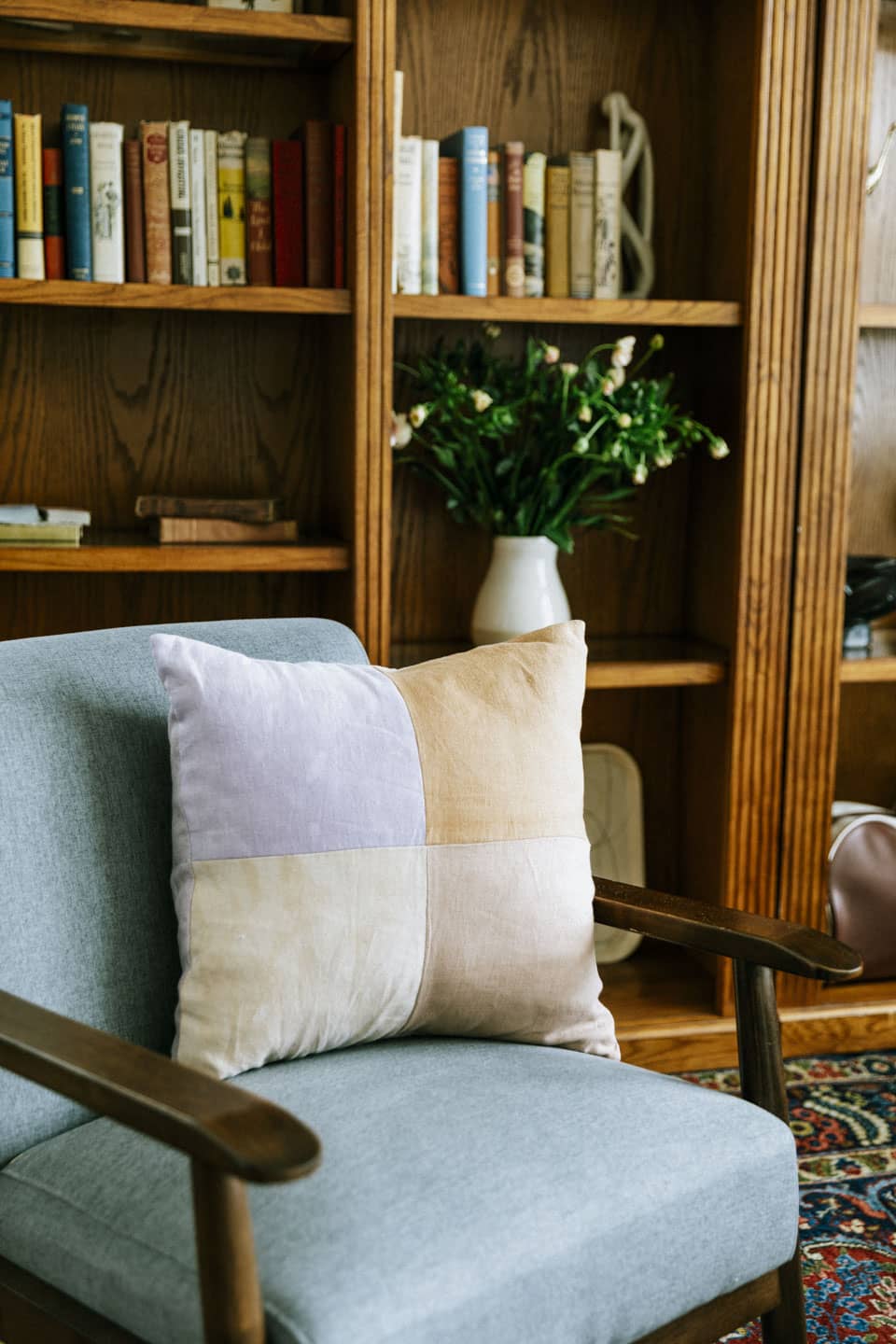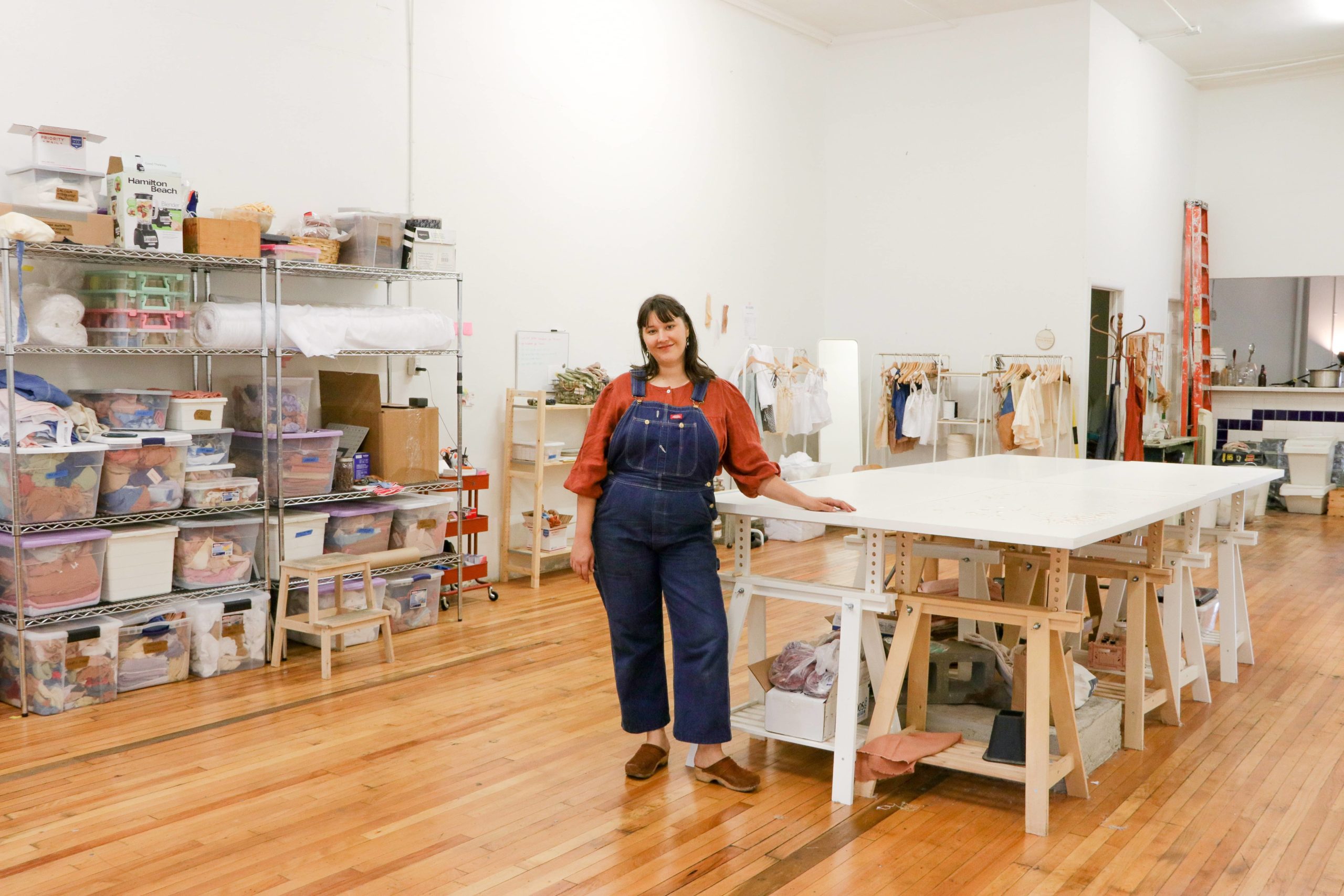What can you do with avocado pits, onion skins, and discarded flowers? Meghan Navoy uses them as plant dyes for her sustainable textile studio Rosemarine Textiles.
Navoy started the Detroit-based business in January 2018 after learning about the environmental impact of the wedding and events industry. At the time, Navoy was planning for her own wedding and decided to make a sustainable alternative by creating wedding napkins and tablecloths using natural plant dyes.
Today, Rosemarine Textiles offers home goods and accessories such as pillows, bandanas, and scrunchies made from sustainably and ethically produced fabrics and plant dyes like chestnuts, indigo, and red onion skins.
Q&A with Meghan Navoy, Founder of Rosemarine Textiles
Hello Alice caught up with Navoy to discuss using content to connect with customers, why trade shows are worth it, and how to be a profitable business without sacrificing your soul.
How did you get into natural plant dyes?
I went to school in New York for textiles. I was really interested in learning about climate change and the impact of the fashion industry and the textile industry and exploring different alternatives to that. I heard a talk from Liz Spencer who was talking about her natural dye practice, and that was the first time I’d ever heard about it. I immediately became obsessed with the concept of dyeing fabrics with different plants.
A couple of my friends and classmates decided to do this project. I can’t believe it even actually worked! We had the right amount of support from the school: They had this balcony and gave us the funding, and we organized this entire natural dye garden. Now there’s a club that takes care of it, and people grow all different types of plants there. The fashion design department can use it; the textile design department can use it. Everyone at the school can experiment with natural dyeing in the garden right now.
That’s so cool! It sounds like studying textiles and learning more about the environmental impact of the fashion industry made you want to use more sustainable materials for your brand.
Definitely, we learned a lot about what direction the industry was moving in to figure out ways to utilize less water or how to recycle synthetic fibers. There was a big focus on regenerative practices and learning more about how the industry is trying to become better when I was at school.
What was the deciding factor to expand your offerings beyond weddings and events?
I realized my customers were not necessarily brides but more florists and event planners. My customer was interested in not just purchasing something for their clients, but they also wanted to get something for themselves.
How do you source your materials such as your plant dyes and textiles?
I try to source my materials from as many small woman-owned and minority-owned businesses as possible. I work with a couple of different natural dye vendors who sell the powdered version of the plant dyes. I also grow some of my own plants in my garden, like Japanese indigo and marigolds that I use for dyeing.
We came out with a line of pillows this year, and I knew that I didn’t want to use a polyester fiberfill pillow insert, and I also didn’t want to use down because of animal cruelty concerns. So I found this amazing company in upstate New York that hires developmentally disabled adults to make GOTS-certified organic cotton inserts. It’s a family-run company, and they’re so nice, and they provide opportunities to people who may have difficulty getting another type of job. It’s a lot more expensive than polyester inserts, but you can sense the difference when something’s a quality, handmade item.
I also work with a California-based fabric importer that’s family-owned. It’s a bunch of cool hippies in California that are lovely to work with. It feels good to know that my business is working with people who are just so lovely, and we have a personal relationship.

How do you go about designing your pieces? Do you design based on what you like or on what connects with your customers?
A lot of things that have been the most popular are just when I’m experimenting on my own at my studio, coming up with new ideas. I’d post a picture of it on my Instagram stories or include it in my blog, and it’d get a huge response of people being interested like, “Oh, are you going to offer that? Are you going to make that?” It’s really helpful to have that immediate feedback. I’m making something for me but then seeing what resonates with my customers as well.
[Hello Alice Guide: Establish Your Social Media Presence]
How did you get the word out about your business?
Instagram has been one of my main platforms. I also have an email newsletter that I send out once or twice a month, which I like because things can get easily lost in social media, and newsletters are a better, organic way to connect with people. I started a YouTube channel this past year, which is a really fun medium to show more about what our process is, how everything’s made, and the human side of the product.
[Hello Alice Guide: Create Your YouTube Channel]
Does selling through different platforms like Etsy also help with getting your brand out there?
As a small business owner, I try to get as many potential customers looking at my business as possible. I don’t want to spread myself too thin on too many different platforms, but Etsy has been a really great community that has supported me so much. I’m glad to have both my main website and my Etsy because the downside of Etsy is whenever you buy something, you don’t say, “Oh, I got this from Rosemarine Textiles.” People just say, “I got this on Etsy.” When you have your own website, I can have my blog and other content that live alongside my products — it’s more than just the shop.
Your products are also sold in many retailers. What was the process of finding those retailers?
In the beginning, I made a list of all the stores that I wanted to sell at. I made a template, and I cold emailed people, but that was only marginally effective. I highly recommend using a wholesale platform called Faire. That’s how a lot of my stockists found me.
In August 2019, I did my first ever trade show, which was scary and a huge commitment because it’s a pretty big investment. But I did a Kiva loan, so I could afford to go there. I also did the Shoppe Object tradeshow in New York, and that was a huge game-changer because I got to talk to so many different stores. I got orders from ABC Carpet & Home and Anthropologie and all of these exciting retailers. My wholesale business is doing well right now, so I don’t have to do trade shows anymore, but I would recommend it. I know people say, “Well because there’s the internet, are trade shows even worth it?” But if you find one with a really good fit for your brand that seems highly curated, it can be worth it.
In your advice to entrepreneurs, you had said that there are ways to be a profitable, sustainable, and ethical business. Could you expand on that?
I’m a textile artist, but I’m also interested in the business side and human rights. It’s disappointing sometimes when you hear of small businesses that you think are really cool, but then they treat their employees badly. I feel like it’s a false system of scarcity that you have to follow in a textbook way around your business when you can make sure that people are paid fairly and source materials that are not exploitative. You can make your own decisions about your business and not worry about taking your heart and soul out to be a business owner.
What’s the biggest business lesson that you’ve learned so far?
I learned that you personally know what’s best for your business. Lots of different people will say, “Oh do this or don’t do that,” but at the end of the day, you as a business owner know what your vision is and you know the direction that you want to go in.
Also, especially on social media, there is a strong sense of overnight success for a lot of people. When I was first starting my business, I wanted to be one of those shops that when they do a shop update, everything sells out in like five minutes. But my friend told me that growing your business is less of an overnight success, but more like a slow burn over many years where your brand slowly gets bigger and bigger. Things are rarely an overnight success — it’s better to focus on cultivating your slow burn than hoping for a random viral moment.
For more small business tips and inspiration create a free account on Hello Alice or subscribe to our weekly newsletter.
